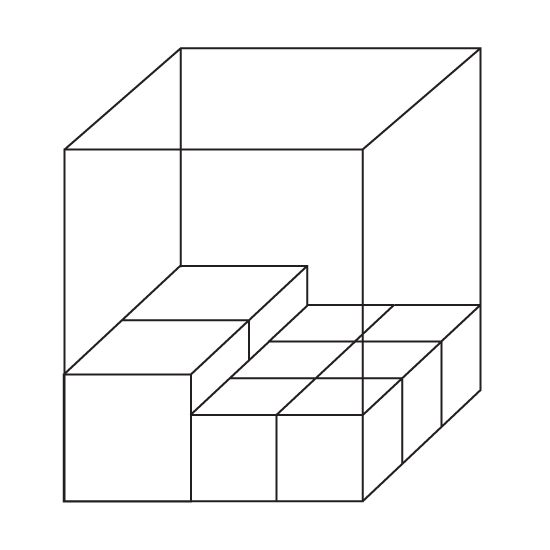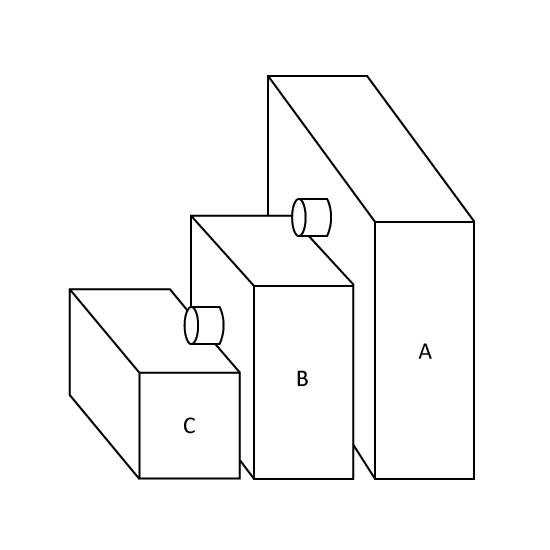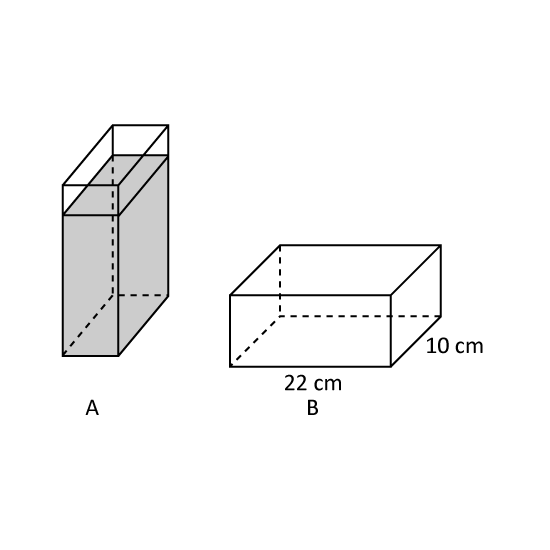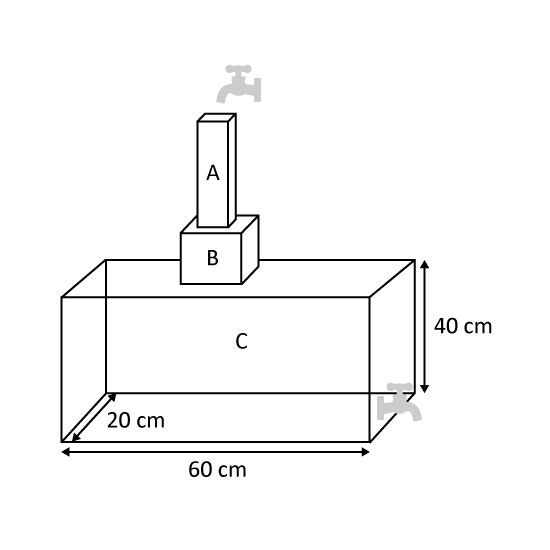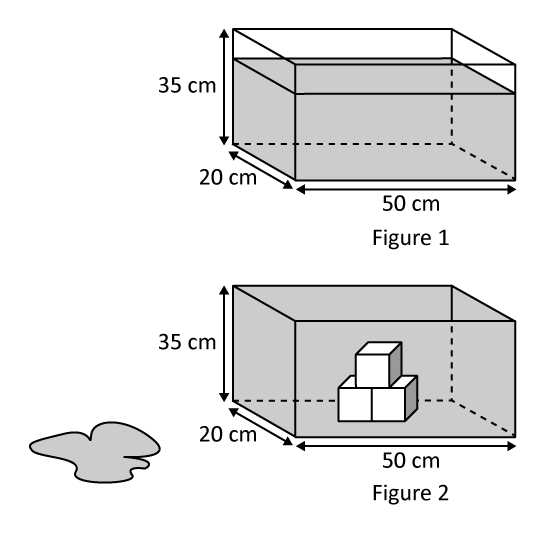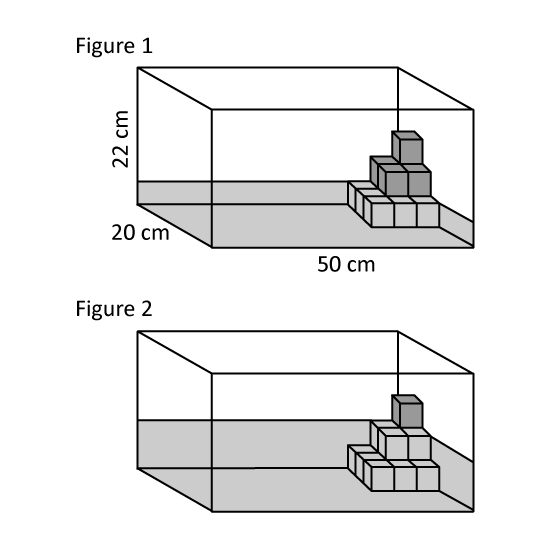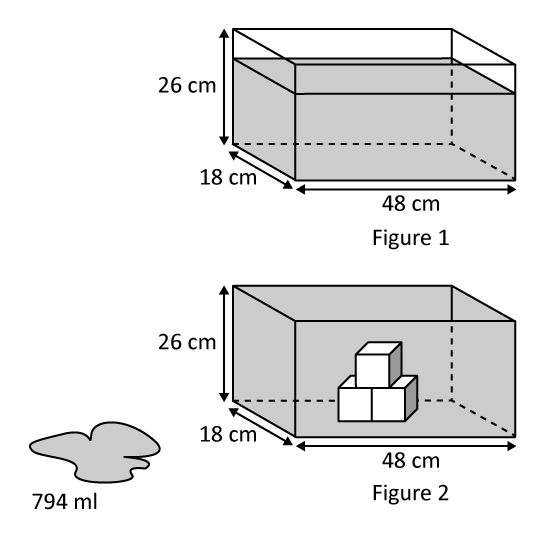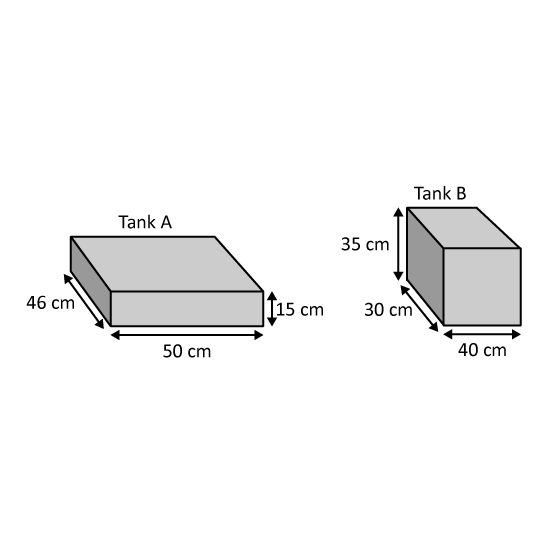Level 3 PSLE
David has 8 large cubes and some small cubes. He placed them in a rectangular tank. The tank was filled to the brim exactly. The diagram shows the first layer of cubes.
- How many small cubes does David have?
- The volume of the tank is 504 cm3. If the large cubes took up 37 of the tank, What is the length of the edge of one small cube?
Level 3 PSLE
David has 8 large cubes and some small cubes. He placed them in a rectangular tank. The tank was filled to the brim exactly. The diagram shows the first layer of cubes.
- How many small cubes does David have?
- The volume of the tank is 504 cm3. If the large cubes took up 37 of the tank, What is the length of the edge of one small cube?
Image in this question is not available.
Level 3
In the diagram not drawn to scale, Tank J and Tank K each has a button that, when pressed, will cause the water to flow out if the water level is higher than the hole. Tank J measures 134 cm by 42 cm by 137 cm. Tank K measures 55 cm by 21 cm by 68 cm. Tank L is 69 cm by 20 cm by 26 cm. Both holes are located at a height of 14 cm from the top of their respective containers. When Tank J is completely filled with water and both buttons are pressed, what will be the final water level in Tank L?
Level 3
In the diagram not drawn to scale, Tank J and Tank K each has a button that, when pressed, will cause the water to flow out if the water level is higher than the hole. Tank J measures 134 cm by 42 cm by 137 cm. Tank K measures 55 cm by 21 cm by 68 cm. Tank L is 69 cm by 20 cm by 26 cm. Both holes are located at a height of 14 cm from the top of their respective containers. When Tank J is completely filled with water and both buttons are pressed, what will be the final water level in Tank L?
Image in this question is not available.
Level 3 PSLE
A and B are two rectangular containers. The base area of A is 30 cm
2 and the base of B has dimensions as shown. A contained 750 cm
3 of water and B was empty.
- What was the height of the water level in A?
- Ben poured some water from A into B without spilling. After that, the height of the water level of A was the same as that of B. How much water did Ben pour into B?
Level 3 PSLE
A and B are two rectangular containers. The base area of A is 30 cm
2 and the base of B has dimensions as shown. A contained 750 cm
3 of water and B was empty.
- What was the height of the water level in A?
- Ben poured some water from A into B without spilling. After that, the height of the water level of A was the same as that of B. How much water did Ben pour into B?
Image in this question is not available.
Level 3
Tank A measuring 40 cm by 17 cm by 146 cm is filled with water. Tank B is with a square base of side 68 cm is empty. Water is poured from Tank A into Tank B until the water level in Tank B is twice the height of the water in Tank A. What is the height of the water level in Tank B?
Level 3
Tank A measuring 40 cm by 17 cm by 146 cm is filled with water. Tank B is with a square base of side 68 cm is empty. Water is poured from Tank A into Tank B until the water level in Tank B is twice the height of the water in Tank A. What is the height of the water level in Tank B?
Image in this question is not available.
Level 3 A tank was completely filled with water. The ratio of the length of the tank to its breadth to its height is 8 : 4 : 15.
- Given that the height of the tank is 45 cm, find the volume of water in the tank.
- All the water in the tank was poured into 2 empty bottles A and B without spilling any water. As a result, Bottle A had 1500 cm3 more water than Bottle B. Find the volume of water in Bottle A. Give your answer in litres.
4 m
Image in this question is not available.
Level 3
An empty tank measures 50 cm by 20 cm by 35 cm. 3 wooden cubes each of edge 10 cm, are placed in the tank. The tank is then filled with water flowing from a tap at a rate of 8 ℓ per minute.
- How long will it take to fill up the tank? Express your answer in min.
- What will be the depth of the water in the tank after 2 wooden cubes are removed?
Level 3
An empty tank measures 50 cm by 20 cm by 35 cm. 3 wooden cubes each of edge 10 cm, are placed in the tank. The tank is then filled with water flowing from a tap at a rate of 8 ℓ per minute.
- How long will it take to fill up the tank? Express your answer in min.
- What will be the depth of the water in the tank after 2 wooden cubes are removed?
Image in this question is not available.
Level 3
This figure is not drawn to scale. A rectangular glass tank 72 cm by 50 cm by 35 cm has 2 compartments, X and Y, with a water height of 30 cm in X and 15 cm in Y. A hole in the slider caused water to leak from X to Y. It was found that the water level in both compartments became the same after some time.
- What is the height of water in the tank now?
- It took 112 h for the water in both compartments to reach the same level. Assuming that water leaked at a constant rate, how much water flowed from X to Y in 1 minute? Express the answer to 1 decimal place in cm³.
Level 3
This figure is not drawn to scale. A rectangular glass tank 72 cm by 50 cm by 35 cm has 2 compartments, X and Y, with a water height of 30 cm in X and 15 cm in Y. A hole in the slider caused water to leak from X to Y. It was found that the water level in both compartments became the same after some time.
- What is the height of water in the tank now?
- It took 112 h for the water in both compartments to reach the same level. Assuming that water leaked at a constant rate, how much water flowed from X to Y in 1 minute? Express the answer to 1 decimal place in cm³.
Image in this question is not available.
Level 3
A tank measuring 50 cm by 20 cm by 22 cm, with some cubes placed inside, was filled with 3.875 ℓ of water to the height as shown in Figure 1. Some water was then added into the tank to the height as shown in Figure 2. The total volume of water in the tank then became 8.375 ℓ. What was the volume of one cube?
Level 3
A tank measuring 50 cm by 20 cm by 22 cm, with some cubes placed inside, was filled with 3.875 ℓ of water to the height as shown in Figure 1. Some water was then added into the tank to the height as shown in Figure 2. The total volume of water in the tank then became 8.375 ℓ. What was the volume of one cube?
Image in this question is not available.
Level 3
A rectangular tank measuring 48 cm by 18 cm by 26 cm was filled with 18.8 litres of water as shown in Figure 1. When three identical wooden blocks were put into the tank, 794 mℓ of water overflowed from the tank as shown in Figure 2. Find the volume of one such wooden block.
Level 3
A rectangular tank measuring 48 cm by 18 cm by 26 cm was filled with 18.8 litres of water as shown in Figure 1. When three identical wooden blocks were put into the tank, 794 mℓ of water overflowed from the tank as shown in Figure 2. Find the volume of one such wooden block.
Image in this question is not available.
Level 3
Tank A measuring 50 cm by 46 cm by 15 cm contained 34 ℓ of water. Tank B measuring 40 cm by 30 cm by 35 cm contained 18 ℓ of water. Alan poured some water from Tank A into Tank B without spilling and the water level of Tank B rose to 28 cm. What was the height of water level left in Tank A?
Level 3
Tank A measuring 50 cm by 46 cm by 15 cm contained 34 ℓ of water. Tank B measuring 40 cm by 30 cm by 35 cm contained 18 ℓ of water. Alan poured some water from Tank A into Tank B without spilling and the water level of Tank B rose to 28 cm. What was the height of water level left in Tank A?
Image in this question is not available.
